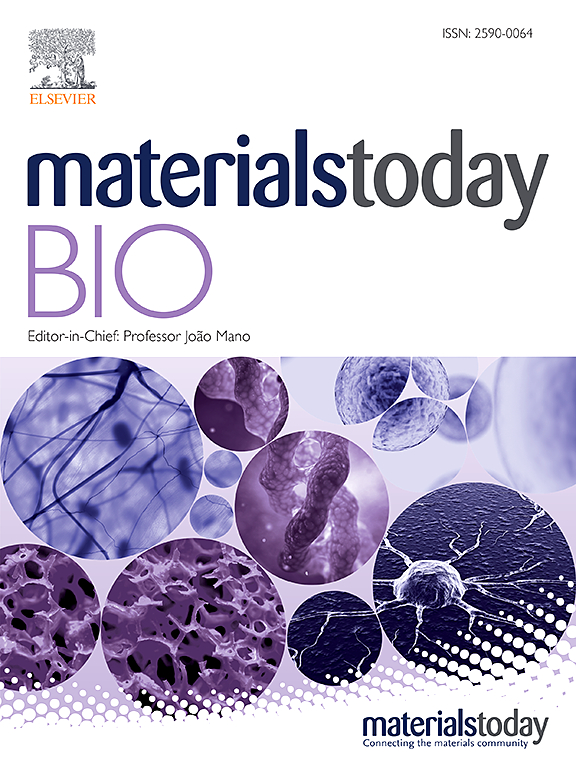Smart bactericidal textile enabling in-situ visual assessment of antimicrobial activity
IF 8.7
1区 医学
Q1 ENGINEERING, BIOMEDICAL
引用次数: 0
Abstract
Hospital fabrics and wound dressings with antibacterial properties are essential to minimize infection risks associated with bacterial colonization of textiles. A key challenge of these materials lies in the difficulty in assessing their functional lifespan. Integrating bacterial-sensing elements into smart textiles enables real-time and in-situ evaluation of antibacterial activity. However, this approach is often hindered by the reactivity between bactericidal and bacterial-sensing components, the limited stability and selectivity of the sensing probes, and high production costs. Here, we address these challenges by presenting a smart textile that simultaneously provides antibacterial activity and bacterial-sensing capacity using a layer-by-layer sonochemical deposition method. Prussian blue, a chromogenic bacterial-sensing probe, is integrated onto hospital-grade antibacterial fabrics containing copper oxide nanoparticles. When the biocidal fabric begins to lose its antimicrobial activity, live bacteria in the textile metabolically reduce Prussian blue nanoparticles, triggering a visible colour change. This approach offers several key advantages, such as: (i) the resulting textile retains antibacterial activity comparable to conventional copper oxide-based textiles (A value > 4 in both cases); (ii) it provides a direct and visible colour transition from blue to colourless (>20 % colour losses) when the antibacterial coating begins to lose effectiveness, enabling straightforward monitoring of antibacterial lifespan without external instruments or reagents; (iii) the co-immobilization enhances coating stability, nearly doubling the binding strength of copper oxide and Prussian blue compared to single-layer coatings; and (iv), the additional Prussian blue layer significantly reduces the material cytotoxicity, enhancing biocompatibility for safer use in healthcare settings. These innovations offer a scalable, cost-effective, and multifunctional solution for infection control. The smart textile not only prevents bacterial spread but also provides timely, visual indications of coating degradation, making it a promising tool for improving patient safety in hospitals and for minimizing infection risks in schools and other high-risk environments.

智能杀菌纺织品,可现场直观评估抗菌活性
具有抗菌性能的医院织物和伤口敷料对于尽量减少与细菌在纺织品上定植有关的感染风险至关重要。这些材料的一个关键挑战在于难以评估其功能寿命。将细菌传感元件集成到智能纺织品中,可以实时和现场评估抗菌活性。然而,这种方法经常受到杀菌和细菌传感组分之间的反应性、传感探针有限的稳定性和选择性以及高生产成本的阻碍。在这里,我们通过提出一种智能纺织品来解决这些挑战,该纺织品使用逐层声化学沉积方法同时提供抗菌活性和细菌感应能力。普鲁士蓝,一种显色细菌感应探针,被集成到含有氧化铜纳米粒子的医院级抗菌织物上。当这种杀菌织物开始失去抗菌活性时,纺织品中的活细菌会通过代谢减少普鲁士蓝纳米粒子,从而引发可见的颜色变化。这种方法具有几个关键的优点,例如:(i)所得纺织品保持与传统的氧化铜基纺织品相当的抗菌活性(A值>;两种情况均为4);(ii)当抗菌涂层开始失效时,它提供了从蓝色到无色(20%颜色损失)的直接和可见的颜色转变,无需外部仪器或试剂即可直接监测抗菌寿命;(iii)共固定化提高了涂层的稳定性,与单层涂层相比,氧化铜和普鲁士蓝的结合强度几乎增加了一倍;(iv)额外的普鲁士蓝层显著降低了材料的细胞毒性,增强了生物相容性,以便在医疗保健环境中更安全地使用。这些创新为感染控制提供了一种可扩展的、具有成本效益的多功能解决方案。这种智能纺织品不仅可以防止细菌传播,还可以及时提供涂层降解的视觉指示,使其成为提高医院患者安全、最大限度地降低学校和其他高风险环境感染风险的有前途的工具。
本文章由计算机程序翻译,如有差异,请以英文原文为准。
求助全文
约1分钟内获得全文
求助全文
来源期刊

Materials Today Bio
Multiple-
CiteScore
8.30
自引率
4.90%
发文量
303
审稿时长
30 days
期刊介绍:
Materials Today Bio is a multidisciplinary journal that specializes in the intersection between biology and materials science, chemistry, physics, engineering, and medicine. It covers various aspects such as the design and assembly of new structures, their interaction with biological systems, functionalization, bioimaging, therapies, and diagnostics in healthcare. The journal aims to showcase the most significant advancements and discoveries in this field. As part of the Materials Today family, Materials Today Bio provides rigorous peer review, quick decision-making, and high visibility for authors. It is indexed in Scopus, PubMed Central, Emerging Sources, Citation Index (ESCI), and Directory of Open Access Journals (DOAJ).
 求助内容:
求助内容: 应助结果提醒方式:
应助结果提醒方式:


